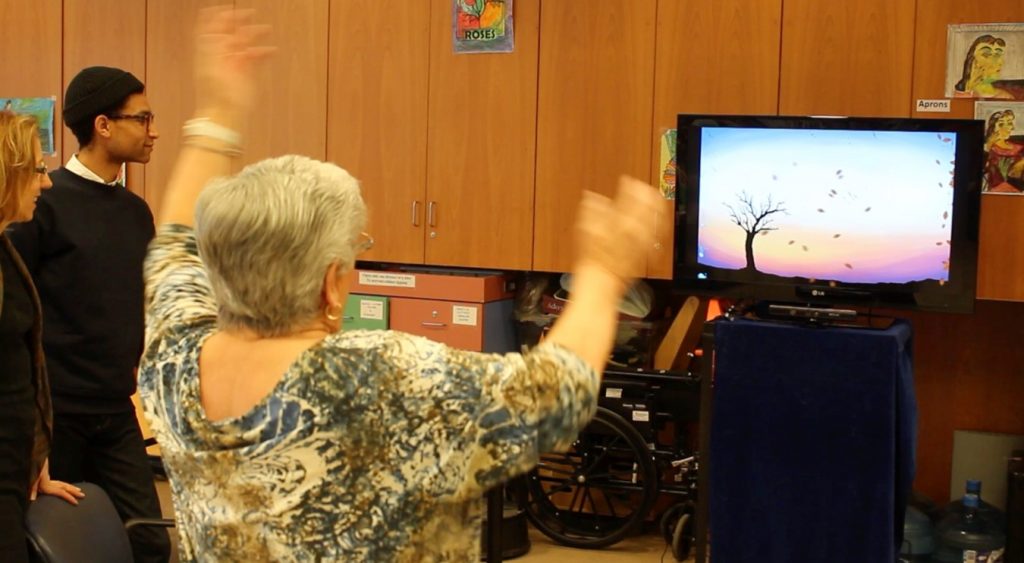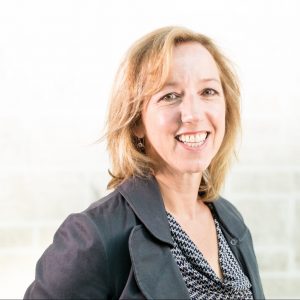Grandma’s got game

January 25, 2018
When Paula Gardner and her now-PhD student, Stephen Surlin, tested out their new interactive software with seniors at Toronto’s Baycrest geriatric hospital a couple of years ago, they got concerned after 20 minutes.
The software was working well – a little too well.
“We were using an interface that allowed the seniors to either digitally paint or create a piece of music by moving their hands,” explains Gardner. “A number of them with fairly low mobility were so enthralled with the platform that they just kept playing and playing. We had to urge them to stop so they could rest – we were worried they’d be sore the next day!”
Potential muscle aches aside, encouraging seniors to move more is exactly the aim of Gardner and Surlin’s Movement and Biometric Feedback Platform, which they’re hoping to develop further, with the help of a Catalyst grant from the McMaster Institute for Research on Aging (MIRA) and its Labarge Centre for Mobility in Aging.
The ABLE project (Arts Based Therapies Enabling Longevity for Geriatric Outpatients) brings together researchers from five McMaster faculties to develop technologies that will enhance the cognitive, physical and emotional health of frail older adults.
Working with geriatric outpatients at Hamilton’s St. Peter’s Hospital, the project aims to use technologies such as a Kinect 2, biometric inputs, data projector, projection screen and speaker system to encourage seniors to be more active. Participants can create a piece of music using the movement of their hands (“It sounds a little like Ravel,” says Surlin), paint a digital picture, or play a game.
Why is helping seniors improve their mobility so important? For frail seniors – those with physical or cognitive limitations – being able to move easily can mean the difference between maintaining a level of independence and succumbing to outright disability or worse.
“There’s a connection between physical health and cognitive health,” explains Gardner. “This platform can be used with specific rehab exercises, or just to encourage movement generally and, in doing that, can also help reduce social isolation and enhance mood through physical activity.”
Adding music, visual art or gaming components to the movement interface makes the experience more pleasant for the user – meaning that it’s more likely to be used regularly, an important consideration in encouraging mobility. Multi-player functionality means that older adults could play specifically designed video games with their grandchildren or caregivers, giving them a vital social connection.
A key priority for the team is using a “design thinking” approach to the project –using feedback from older adults during testing to improve the platform until it best meets the needs of the participants.
“This kind of co-design is key to making sure the experience using the technology isn’t stressful,” explains Gardner. “We also don’t want to make assumptions about what seniors do and don’t want to do. We designed one iteration of the game – where the player used their hands like wind to blow leaves around – and got feedback that it was really boring. The participants wanted more of a challenge.”
The Catalyst grants specifically encourage cross-faculty collaboration in researching mobility in aging. The members of the research team are:
- Gardner, a multimedia design and communications scholar, and McMaster’s Asper Chair in Communications (Faculty of Humanities)
- Alexandra Papaioannou, a geriatrician and executive director of the Geriatric Education and Research in Aging Sciences (GERAS) Centre (Faculty of Health Sciences)
- Courtney Kennedy, an epidemiologist and associate scientific director of GERAS (Faculty of Health Sciences)
- Patricia Hewston, an occupational therapist and post-doctoral fellow with GERAS (Faculty of Health Sciences)
- Laurel Trainor, an expert in perception, movement and music and director of McMaster’s LIVELab (Faculty of Science)
- Rong Zheng, a specialist in capturing and analysing data from wearable sensors and vision-based systems (Faculty of Engineering)
- Amanda Grenier, Gilbrea Chair in Aging and Mental Health (Faculty of Social Sciences)
Working in collaboration allows the individual researchers to combine their expertise, creating a team that produces results greater than the sum of its parts.
“It has been eye-opening to work with colleagues with expertise in Gerontology, Rehabilitation and Computer Science,” says Gardner, the project’s lead investigator. “Together, we’re better able to understand the client population and their immediate needs in detail. We can then quickly craft experiments that will lead us to solutions to meet the needs of this large and unserved population. We can only meet this challenge as a team.”



